#ancient epirus
Explore tagged Tumblr posts
Text
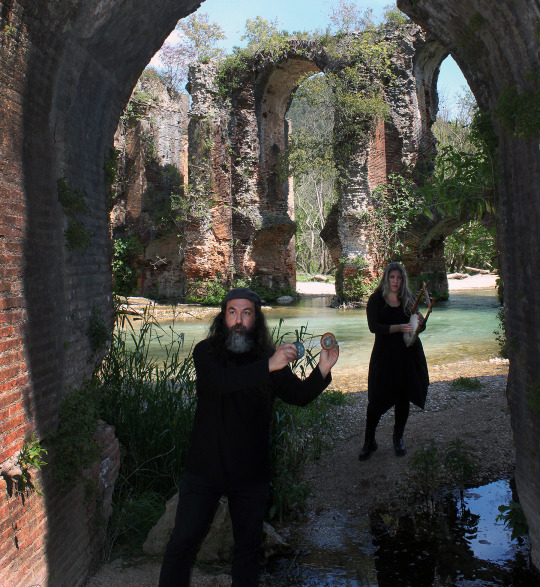
New playlist: 'Ancient Whispers', Music for the Psyche. Including music by Daemonia Nymphe, Spyros Giasafakis II, Vangelis , Rajna, Hexperos, Joran Elane, Irfan, Priscilla Hernandez - Yidneth and more!
#playlist#newplaylist#ancientwhispers#spotifyplaylist#daemonianymphe#relaxing music#playlist spotify#asmr#asmr whispers#ancient greek music#δαιμονία νύμφη#δαιμονιανυμφη#ancient greek instruments#ancient greek lyra#lyra#lyre#nikopolis#city of victory#epirus#ancient epirus#aqueduct#louros#louros river#Νικόπολη#υδραγωγείο#υδραγωγείο Νικόπολης#αρχαία ελληνικά όργανα#αρχαία λύρα#κύμβαλα#ancient cymbals
4 notes
·
View notes
Text
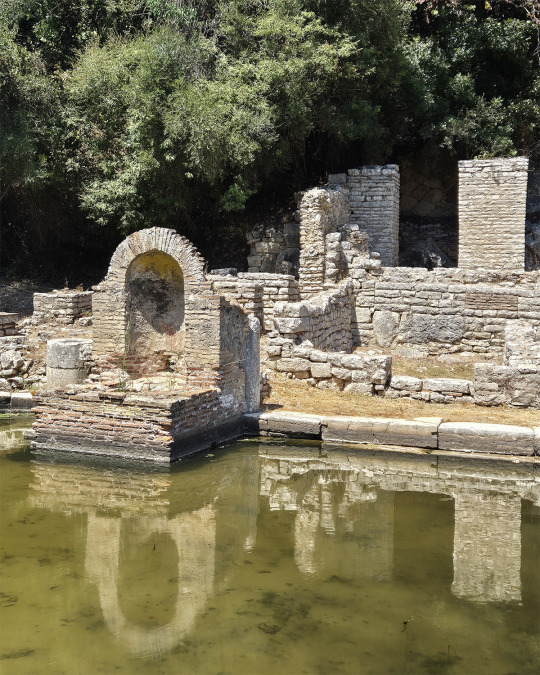
The Roman Forum, Butrint - Albania
Butrint (ancient Bouthrotos/ Buthrotum) was a port in western Epirus, present-day Albania. Julius Ceasar made Butrint a Roman colony in the 1st century BC and allowed his soldiers that fought against Pompey to settle there as a reward. An earthquake destroyed the forum and its adjacent buildings in the late 4th century AD.
#albania#butrint#unesco#ruins#ancint ruins#ancient greece#ancient rome#architecture#culture#unesco heritage#balkans#travel#wanderlust#antiquity#archaeology#history#ancient ruins#acropolis#ancient history#epirus#buthrotum
74 notes
·
View notes
Text

nekromanteio acheronta
© 2024 Yiannis Krikis
#nekromanteio acheronta#lensblr#lensculture#fine art photography#photographers on tumblr#landscape#greece#ancient#epirus#architecture
73 notes
·
View notes
Text

Epirus' Royal family 6 years after the trojan war. They are a mess godbless I love them so much
#tagamemnon#greek mythology#ancient greek mythology#trojan heroes#greek heroes#classics#post the fall of troy#the iliad#pyrrhus#deidamia#andromache of troy#helenus#hermione of sparta#chaon#molossus#laodamas of troy#amphialus#pielus#pergamus#Andromache x helenus x deidamia#epirus gang#mestor took the photo
67 notes
·
View notes
Note
What was Alexander’s relationship with his sisters like?
Short answer: We mostly don’t know.
Longer answer: We have some clues that he may have got on well at least with Kleopatra and Thessalonike. Kynanne is more of a crap-shoot, as she was married to his cousin and rival, Amyntas. But as Philip arranged that marriage, she had little/no say in the matter, so we just don’t know what she thought of her husband-cousin versus her brother. (Not addressing the infant Europe, as she died at just a few weeks.)
First, let me link to an article by Beth Carney, and at the end, I’ll add some links to my own prior entries that address the question too.
Elizabeth Carney, “The Sisters of Alexander the Great: Royal Relics” Historia 37.4 (1988), 385-404.*
Beth’s article discusses Argead marriage policies, and the fate of the women after ATG’s death. I know she’s changed her mind about a few things, but it’s still well worth reading.
Also, a general reminder to folks who may be new to Alexander/Macedonia … Macedonian kings practiced royal polygamy: e.g., they married for politics, not love, and had more than one wife at the same time. Philip married 7 women (the most of any Macedonian king), although there weren’t 7 wives living in the palace at once. There may have been as many as 5 at times, however.
Because of royal polygamy, they did not use the term basilissa (queen) until after Alexander’s death. The chief wife was the mother of the heir; she had the most power. Because of the rivalry inherent in such courts, a woman’s primary allegiance was to her son, not her husband. Her secondary allegiance would be to her father (if living) and/or brothers. This was not unique to Macedonia, but a feature of most courts with polygamous structures.
These are not love matches, although our later sources may present them as love matches. (These authors had their own ideological reasons for such characterizations.) Did love never come after marriage? Perhaps. It would have depended. Also, within the women’s rooms, wives may have allied with each other at points, particularly if several of them. If only two (as seems more characteristic in Macedonia, aside from Philip), they’d have been rivals seeking to produce the heir.
I state all that to explain why Alexander’s sisters may have courted their brother’s affection (and protection), after Philip’s death. Only Kleopatra had a son, and he was 12 at most at Alexander’s death.

In his final year, Philip married off Alexander’s older sister, Kynanne (d. of Audata, ergo half- Illyrian), and Alexander’s younger and only full sister, Kleopatra (d. of Olympias). Kleopatra’s wedding was literally the day before Philip’s assassination. The timing of Kynnane’s marriage is less clear, but Philip married her to Amyntas, his nephew (her cousin), some time after his own marriage to his last wife, Kleopatra Eurydike. Kynnane had a daughter by Amyntas, Hadea (later Hadea Eurydike). We’re not sure if she was born before or after her father’s execution by Alexander, but it does let us nail down her age to c. 12/13 at Alexander’s death.
After he had Amyntas executed, Alexander planned to marry Kynnane to one of his trusted allies, Langaros, king of Agriana, which lay north of Macedonia, between Paionia and Illyria. Agriana was arguably Paionian, but similar to Illyria. Ergo, this may show a bit of thoughtfulness on Alexander’s part, to match his sister to a man who wouldn’t attempt to trammel her. Recall that Illyrian women wielded more power and even fought in battle. Yet Langaros died (perhaps of injury) before Alexander could make good on that.
It would be the last time Alexander planned any nuptials for his sisters. In part because he invaded Persia not long after, but it wouldn’t have stopped him from summoning one of them if he’d really wanted to marry her off.
Kynanne raised her daughter Hadea in traditional Illyrian ways, which Alexander allowed (although he probably couldn’t have stopped her). After his death, she took off to Asia to see Hadea married to her uncle, (Philip III) Arrhidaios. Kynanne was murdered by Perdikkas’s brother Alkestas, because Perdikkas (then regent) didn’t want the marriage. BUT the army (who liked and respected Kynanne) forced Alkestas to allow it anyway. Hadea (now) Eurydike and Philip III Arrhidaios eventually fell under Kassandros’s authority/possession, where she/they opposed Olympias and baby Alexander IV (and Roxane).
It was inevitable that the co-kingship that followed ATG’s death wouldn’t hold, and Hadea, who clearly wore the pants, wasn’t about to step aside for her cousin Alexander IV. Nor did Kassandros want them to, as he could control them. He couldn’t control Olympias. Yet none of that would necessarily reflect how Kynanne and Hadea had felt about their brother/uncle during his lifetime.
So, we must say the jury is out on Kynanne’s relationship with Alexander.
But for Kleopatra and Thessalonike, I do believe we have enough hints that they cared for him and he for them.
Kleopatra’s husband (another Alexander, of Epiros) died in combat in Italy in 332—around the time Alexander was besieging Tyre and Gaza, or four years after their marriage. In that time, Kleopatra produced two children, a girl (Kadmea) and a boy (Neoptolemos). The girl was named to honor her uncle’s victory over Thebes,** which happened at the tail-end of 335. As Alexander of Macedon and Alexander of Epiros both left on separate campaigns in 334, the boy would have to have been fathered not long after Kadmea was born. (It’s possible that Alexander of Epiros didn’t get to Italy until 333.)
After Alexander of Epiros’s death, Kleopatra did not marry again, although after her brother died, she had a couple marriage offers/offered marriage herself. She was THE prize during the early Successor wars…the full sister of Alexander.
Two titbits might suggest she was close to him (even if he didn’t marry her off again). First, the name of her first child is for his victory, not one by her husband. Sure, Alexander of Epiros didn’t have a battle victory at that point to name her for…but he could have insisted on a family name. Instead, he let Kleopatra give the child a name celebrating Alexander of Macedon’s victory. I suspect she fought for that.
Second, an anecdote reports that when Alexander was told his sister was having an affair some years after she’d become a widow, he reportedly replied, “Well, she ought to have a little fun.” This, btw, was viewed as a bad answer…e.g., he didn’t properly discipline her. As Alexander was constantly used for moral lessons (good or bad), we should take it with a grain of salt. But it’s possible his approximate reaction was preserved and became fodder for moralizing about those wild, half-barbarian Macedonians from the north…couldn’t keep their women in check!
As for Thessalonike, data here is also circumstantial. She stayed with Olympias after Alexander’s death and was never married until after Olympias herself was killed by Kassandros—who then forced her to marry him to cement his claim to the Macedonian throne. She had a sad life, at least in her latter years. Her eldest son (Philip) wasn’t healthy and died not long after he became king. Her second son (Antipatros) and her last son (Alexandros) apparently hated each other. After Philip’s death, Thessalonike argued that Antipatros should co-rule with the younger Alexandros. So Antipatros killed his mother! (Matricide, folks, is SUPER-bad.) Then Alexandros killed Antipatros, and was eventually killed in turn by Demetrios Poliorketes.
Well, if Justin can be trusted, and there are problems with Justin. Ergo, it’s possible that internecine spate of murders didn’t go the way Justin reports.
Yet the naming of her youngest boy may tell a story, along with her insistence that he co-rule with his brother.
There’s also the legend of Mermaid Thessalonike, but we can’t take that as any sort of evidence.
Here are some additional posts that also talk about the sisters:
“Writing Kleopatra and Alexander’s Other Sisters” — Although aimed primarily at the novels, it obviously must deal with the girls as historical persons. Pretty short for me.
“What Philip Thought about His Other Children” — A sideways take on this same question. Not long.
“On Amyntas” — About Alexander’s older cousin, his real rival for the throne when Philp was assassinated. Also discusses Kynanne as a matter-of-course. Not long.
“On Kassandros” — Mostly about Antipatros’s son Kassandros, who had Alexander IV murdered, but also discusses Thessalonike, who he forced to marry him. Relatively long.
--------------------------------------------
* The link takes you to academia.edu, where, by clicking on Beth’s name, you can find more of her articles. Keep in mind the woman has something north of 150, many on women, PLUS a bunch of books. Not everything is uploaded due to copyright, but several of her older articles are, such as this one.
** It was something of a “thing,” at least in Macedon, for daughters to be named in honor of their father’s victories. Kynanne not so much, but Kleopatra means “Glory of Her Father,” and both Thessalonike (Victory in Thessaly) and Europe (Victory in Europe) reflected their father’s triumphs.
#asks#alexander the great#alexander the great's sisters#kleopatra of macedon#thessalonike of macedon#kynnane of macedon#hadea eurydike#philip II of macedon#philip of macedon#alexander of epirus#classics#ancient macedonia#ancient greece#alexander's sisters#ancient greek family relations
19 notes
·
View notes
Text

Fabricius and Pyrrhus, Ferdinand Bol, 1656
#art#art history#Ferdinand Bol#historical painting#ancient history#Ancient Rome#Roman history#Roman Republic#Hellenistic history#Pyrrhus of Epirus#allegory#allegorical art#Dutch Golden Age#Baroque#Baroque art#Dutch Baroque#Dutch art#17th century art#oil on canvas#Royal Palace of Amsterdam
76 notes
·
View notes
Text

Albanians: in the 1000s BC the southern part of what would become Albania fell within the northernmost borders of the ancient Greek kingdom of Epirus, while various Illyrian tribes continued to dominate to the north until they were gradually conquered by Rome.
4 notes
·
View notes
Note
Do you perhaps remember in school where they taught us about women throwing pots from their balconies to prevent their soldiers from coming to their city? I don't remember if it was during the Peloponnese war or somewhere different, but i remember we were laughing in class when the teacher was describing us this scene. 😅
Their soldiers? I know about enemies. This was a must in every Greek school history lesson but why can't I find it anywhere on the Internet????? The only relevant thing I found was when King Pyrrhus was killed by a woman throwing a brick at him from her rooftop in the Battle of Argos. (The Battle of Argos took place in 272 BC and was fought by King Pyrrhus of Epirus - who was trying to expand his influence in the Peloponnese - against Argos, Sparta and Macedonia.)
But the general tendency of women to throw stuff from their rooftops honestly is mentioned so often at school that I don't know why I can't find more info online right now...
35 notes
·
View notes
Text
Obverse: Head of Zeus of Dodona, bearded, to left, with crown of oak leaves. Below: Greek letter alpha. Reverse: Dione seated sidewise to left on throne with high double back, her right foot drawn back on a footstool; she wears chiton and high crown, draws her himation about her in raised left hand, and holds a sceptre on right shoulder in lowered right hand. Her hair is represented by beaded lines. Greek inscription at right and left.
---
Dione, in Greek mythology, a consort and, at Dodona in Epirus, a cult partner of Zeus, the king of the gods. Since the partner and wife of Zeus was normally the goddess Hera, it has been conjectured that Dione is an older figure than Hera. Dione was variously described. In the Iliad she is mentioned as the mother of the goddess Aphrodite by Zeus; in Hesiod’s Theogony, however, she is simply identified as a daughter of Oceanus. Other writers have identified her as the mother of Dionysus.
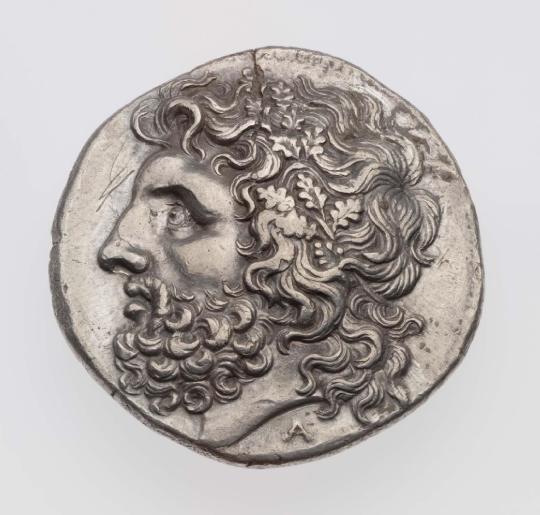
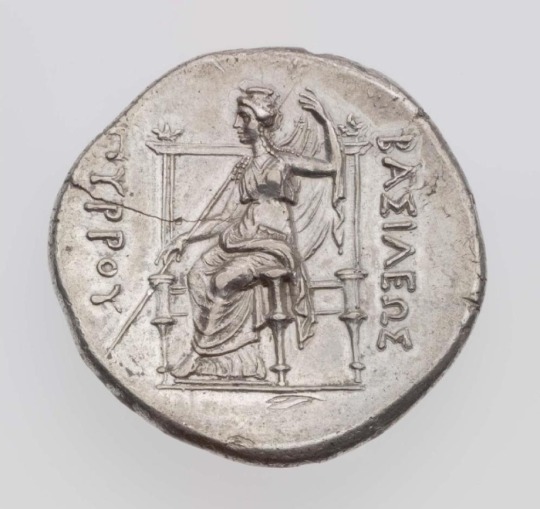
~ Tetradrachm of Lokroi Epizephyriori with head of Zeus, struck under Pyrrhos of Epiros.
Culture: Greek
Period: Early Hellenistic
Date: 280–277 B.C.
Medium: Silver
#studyblr#history#classics#numismatics#coins#greek mythology#ancient greece#hellenistic greece#locri epizefiri#dodona#pyrrhus of epirus#zeus#zeus naios#dione#hera#aphrodite#homer#hesiod#oceanus#dionysus#the iliad#theogony
549 notes
·
View notes
Text
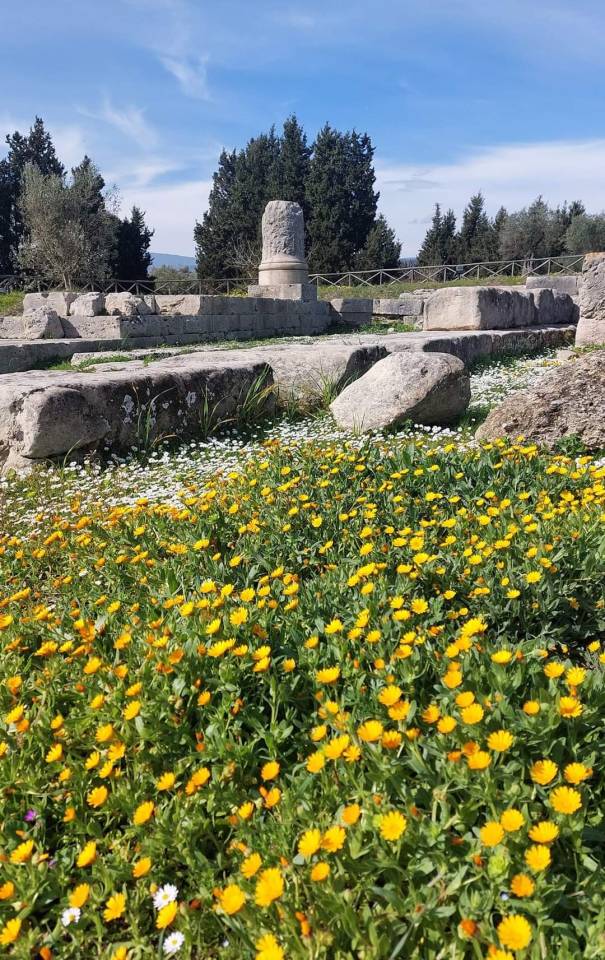

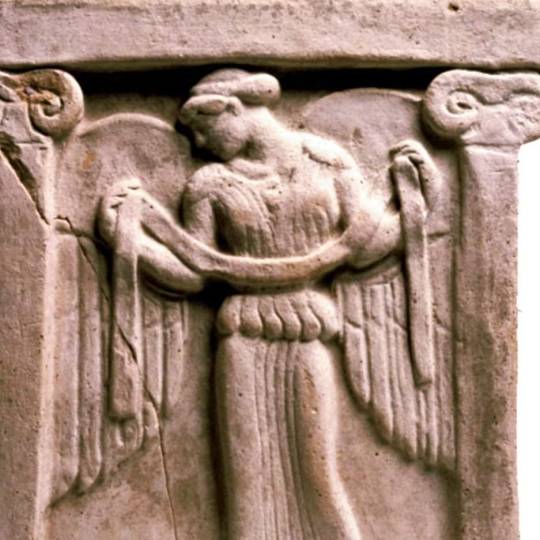
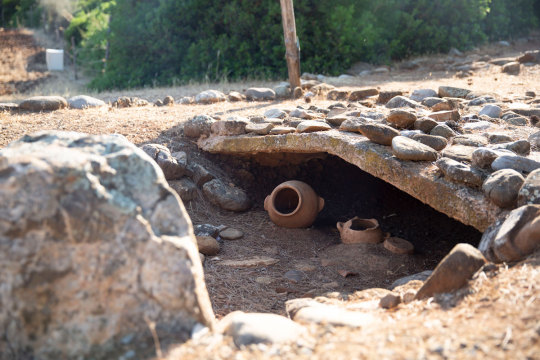
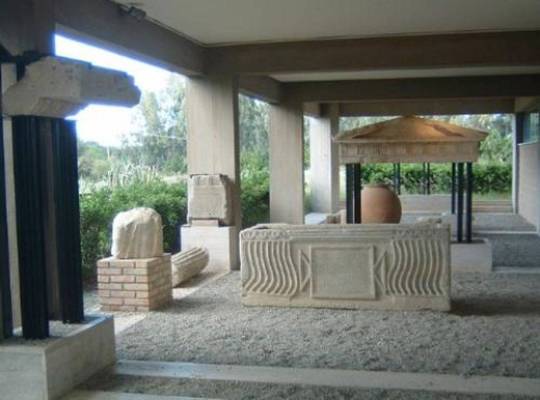
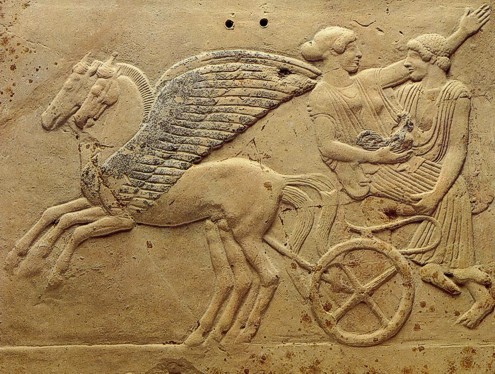

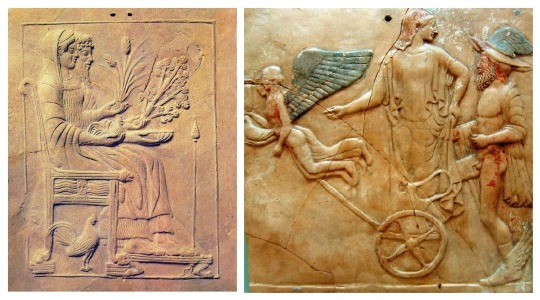


Locri, Calabria, Italy
Locri Epizefiri (Greek Λοκροί Ἐπιζεφύριοι; from the plural of Λοκρός, Lokros, "a Locrian" and ἐπί epi, "on", Ζέφυρος (Zephyros), West Wind, thus "The Western Locrians") was founded about 680 BC on the Italian shore of the Ionian Sea, near modern Capo Zefirio, in Southern Italy's Calabria, by the Locrians, apparently by Opuntii (East Locrians) from the city of Opus, but including Ozolae (West Locrians) and Lacedaemonians.
Due to fierce winds at an original settlement, the settlers moved to the present site. After a century, a defensive wall was built. Outside the city there are several necropoleis, some of which are very large.
Locris was the site of two great sanctuaries, that of Persephone and of Aphrodite. Perhaps uniquely, Persephone was worshiped as protector of marriage and childbirth, a role usually assumed by Hera, and Diodorus Siculus knew the temple there as the most illustrious in Italy.
In the early centuries Locris was allied with Sparta, and later with Syracuse. It founded two colonies of its own, Hipponion and Medma.
During the 5th century BC, votive pinakes in terracotta were often dedicated as offerings to the goddess, made in series and painted with bright colors, animated by scenes connected to the myth of Persephone. Many of these pinakes are now on display in the National Museum of Magna Græcia in Reggio Calabria. Locrian pinakes represent one of the most significant categories of objects from Magna Graecia, both as documents of religious practice and as works of art. In the iconography of votive plaques at Locri, her abduction and marriage to Hades served as an emblem of the marital state, children at Locri were dedicated to Persephone, and maidens about to be wed brought their peplos to be blessed.
During the Pyrrhic Wars (280-275 BC) fought between Pyrrhus of Epirus and Rome, Locris accepted a Roman garrison and fought against the Epirote king. However, the city changed sides numerous times during the war. Bronze tablets from the treasury of its Olympeum, a temple to Zeus, record payments to a 'king', generally thought to be Pyrrhus. Despite this, Pyrrhus plundered the temple of Persephone at Locris before his return to Epirus, an event which would live on in the memory of the Greeks of Italy. At the end of the war, perhaps to allay fears about its loyalty, Locris minted coins depicting a seated Rome being crowned by 'Pistis', a goddess personifying good faith and loyalty, and returned to the Roman fold.
The city was abandoned in the 5th century AD. The town was finally destroyed by the Saracens in 915. The survivors fled inland about 10 kilometres (6 mi) to the town Gerace on the slopes of the Aspromonte.
Today, the modern town of Locri boasts a National Museum and an Archaeological Park, etirely dedicated to the ancient Greek city. The museum preserves the most important findings of the time, such as vases, pinakes, tools used in everyday life, architectural remains from the various excavation area.
Follow us on Instagram, @calabria_mediterranea
#locri#calabria#italy#italia#south italy#southern italy#mediterranean#mediterranean sea#magna graecia#magna grecia#archaeology#archeology#ancient#art#ancient art#history#ancient history#greek#greek art#ancient greece#landscape#italian#italian landscape#landscapes#europe#persephone#olive trees#olive tree#nature#nature photography
206 notes
·
View notes
Photo
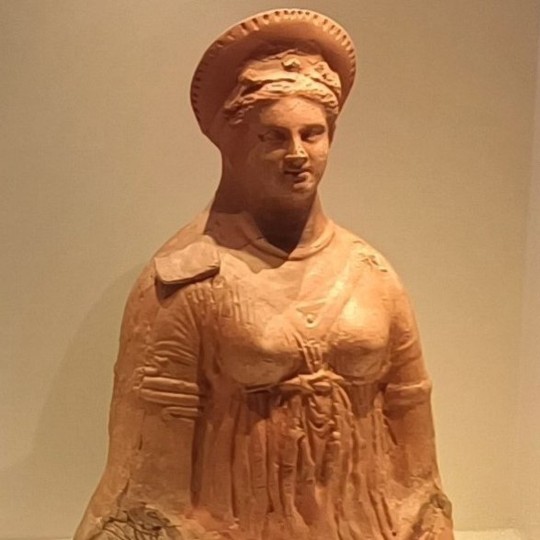
Thessalonike of Macedon
Thessalonike of Macedon (c. 345-295 BCE) was the daughter of Philip II of Macedon (r. 359-336 BCE) and one of his several consorts, Nikesipolis of Pherae (also spelt Nicesipolis). Born to the Argead family of Macedonian rulers like her half-brother Alexander the Great (r. 336-323 BCE), Thessalonike married Cassander (r. 305-297 BCE), and after his death, she probably acted as regent for their sons.
In contrast with such a high profile, historical details about Thessalonike's life are relatively rare. And yet, her character still casts resounding echoes in both myths and history, in her legendary personification as a mermaid and as the eponym of Greek's second largest, emporium city, Thessaloniki.
Birth & Family
The uncertainties around Thessalonike's historical background start with her date of birth. In the absence of direct hints in ancient writings, scholars have tried to use the meaning of her name as a clue. Stephanus of Byzantium, a 6th-century grammarian, in his geographical encyclopedia, Ethnica, notes that 'Thessalian Victory' was an expression to celebrate Philip II's victory (nike) in Thessaly (Ethnica, v. 'Thessalonike'). Philip’s first grand victory in Thessaly, at the Battle of Crocus Field, effectively awarded the king of Macedon with the life-long archonship of this major Greek city-state right at the south of his kingdom. The title was granted to him by the Thessalians themselves, who had initially called for his help to fend off the Phocians. Philip has been openly applauded by both ancient and modern historians for his numerous political and military achievements in Greece. And yet, this enormous boost of his power as the ruler of Thessaly – and, in effect, of all city-state members of the Amphictyonic League – was nothing less than the dawn of Macedonian glory in the Hellenic world, where the Macedonians were always regarded with contempt.
Philip's victory over the Phocians and their allies, a formidable and ferocious force fighting against the Amphictyonic League in the Third Sacred War (354-346 BCE), scored the first auspicious, game-changing point for the League after a series of inconclusive battles. Philip could also reduce the Phocians' capability by securing an alliance with their main supporter in Thessaly, the city of Pherae, by taking Nikesipolis, a young lady from the family of Jason of Pherae – an ex-ruler of Thessaly – most likely as his second wife (marriage is not verbally mentioned to have taken place, although it is hardly doubtful given the context and later events). Therefore, many scholars connect the birth of Philip's new princess - purportedly an immediate outcome of her mother’s union with him - with the Battle of Crocus Field in 353/2 BCE.
This dating, however, may not match comfortably with the other turning points of Thessalonike's life. Philip II was assassinated in 336 BCE at the wedding of his elder daughter, Cleopatra, with her maternal uncle, Alexander I of Epirus (r. 343/2-331 BCE). The marriage was arranged by Philip himself – a common practice in the ancient Greek world, and many other nations' upper classes throughout history, to secure treaties, mitigate hostilities, pay tributes, or forge alliances. However, by the time of his death, Philip had not revealed any plans for Thessalonike's marital future, presumably because she was still very young. She was believed to be only a child when his half-brother, Alexander the Great, succeeded their father and took the lead in Philip's intended crushing campaign against the Persian Empire. Historians have established that royal women of the Argead court became marriageable in their mid-teens. Thessalonike's half-sisters, Cynane and Cleopatra, were given to the men chosen by their father in their late teens. Therefore, it is unlikely that Philip II in 336 BCE had not already introduced a potential son-in-law for a 17-year-old daughter.
A second date that may question 353/2 BCE for Thessalonike's birth is her marriage in 317 BCE or shortly after to Cassander (Kassandros, c. 355-297 BCE), a commander of Alexander the Great and one of the ferocious belligerents in the Wars of the Diadochi, the succession struggle after the death of Alexander the Great. Cassander secured his claim on the Macedonian throne by turning out to be the ultimate winner of the Second War of the Diadochi when he took the strategically important harbour city of Pydna and put the chief claimants of Alexander's crown, his mother Olympias, his Persian wife Roxana (Roxanne) and their son Alexander IV, to death. Still, like the other Diadochi, Cassander also wished for a familial link with the Argeads to justify his succession of Alexander. And Thessalonike, one of the two surviving daughters of Philip II, was ideally close at hand. She was in Pydna with Olympias, who had raised her ever since Nikesipolis' death only 20 days after childbirth.
Cassander
The Trustees of the British Museum (Copyright)
Apart from obtaining justification, scholars believe that Cassander must have hoped to father a new branch of the Argead dynasty with Thessalonike. This could raise at least a few comments from ancient writers had he been marrying a 36-year-old woman. Moreover, in the heat of the Diadochi wars, it would have been even less likely for Olympias to leave her stepdaughter unmarried for such a long time without trying to use her in the fabrication of an empowering alliance with a king and/or commander. Again, relying on her name to figure out a terminus post quem, a date after which she must have been born, scholars now generally agree that Thessalonike was most likely born around 346/5 BCE, after her father's decisive victory that uprooted the Phocian power once and for all and thus terminated the Third Sacred War. Based on this date, she would be around 9 years old on Philip's assassination and in her late twenties at the time of her marriage to Cassander.
Continue reading...
31 notes
·
View notes
Text

"The Gate to Hades" (part 3 in my Orpheus and Eurydice series)
Part3: But Orpheus is not satisfied to sit in solitary mourning. There was a great injustice in the death of his love Eurydice. If the beasts and rocks of the wild woods of Olympia bow before his song, what is to stop him for persuading the spirits of the underworld? Perhaps he can even persuade the King Hades to take pity on him and his lost love. With this determination, he receives directions to the dark gate from the forest nymphs and sets out. Many days later, standing before that gaping black maw, Orpheus shivers. He might never return to the land of the living. He steps forward. He has nothing left to lose.
In Greek literary sources we have varying references to the location of the entrance to underworld. In Homer’s Odyssey, Odysseus must travel to Hades to perform a “Nekyia” ceremony to commune with the dead to receive prophecies. Circe gives Odysseus the vaguest of directions; “…once your ship has crossed flowing Ocean, drag it ashore at Persephone’s groves, on the level beach where tall poplars grow, willows shed their fruit, right beside deep swirling Oceanus. Then you must go to Hades’ murky home, where Periphlegethon and Cocytus, a stream which branches off theriver Styx, flow into Acheron.” – translation by Ian Johnston.
Some scholars believe Homer’s description of the location is based on the real-world temple of the “Nekromanteion” (oracle of the dead) in Ancient Epirus (Northwest Greece). This was a temple of necromancy dedicated to Hades and Persephone where devotees could commune with dead spirits, and was believed to be the entrance to Hades. The temple was located at the meeting point of three rivers; the Acheron (river of woe), Pyriphlegethon (river of fire), and Cocytus (river of lamentation).
Thanks for reading and looking! If you share this image I'll swim the river styx to.give you a high five! Xoxo
Like this art? It will be in my illustrated book with over 130 other full page illustrations coming in march to kickstarter. Please check my links in my linktree in my bio to join the kickstarter notification page. 🤟❤️🏛
#percyjacksonfanart#percyjackson#orpheus#eurydice#percyjacksonandtheolympians#darkacademia#orpheusandeurydice#apollo#lyre#bard#ancientbard#orphic#classicliterature#classicnovels#tylermileslockett#greekmyths#greekgods#truegrittexturesupply
115 notes
·
View notes
Text

nekromanteio acheronta
© 2024 Yiannis Krikis
#nekromanteio acheronta#lensblr#lensculture#fine art photography#photographers on tumblr#landscape#greece#epirus#red#ancient
35 notes
·
View notes
Text

Something awakening in the son of Achillies and the son of Agamemnon
#tagamemnon#greek mythology#classics#greek heroes#ancient greek mythology#post the fall of troy#the iliad#the oresteia#this is silly#pyrrhus of skyros#pyrrhus#pyrrhus of epirus#pyrrhus x orestes#orestes#Achillies#agamemnon#orestes and pyrrhus#gay#epirus gang
15 notes
·
View notes
Text

WIP Wednesday
happy wednesday, everyone! hope you're having a good one! i'm currently in Manchester, visiting a friend and christmas shopping.
thanks for tagging me @that-disabled-princess!
i've already written this entire post once, but tumblr ate it. but i'm nothing if not stubborn.
as well as a snippet from my post-troy wip, you can find below a discussion of ancient greek periods and pregnancies, ancient anatolian food, and a painting.
so first of all, here's a snippet of Hermione, talking about periods:
"Is this not a conversation we should have in private?"
Deidamia laughed, loud as always, but not cruelly. "Oh, they don't mind! Pyrrhus grew up with six aunts and countless girl cousins, he's heard this all before."
I looked at Pyrrhus in surprise, and he shrugged in agreement, expression perplexed, like he didn't see why I was making a fuss about his presence.
"And him?" I jabbed a finger at Helenus.
"I had fifty sisters." He replied, lifting a cup to his lips to unsuccessfully obscure a smirk. Smug bastard. "And I find ginger tea helps more, but apparently that doesn't grow on this forsaken continent." He sighed wistfully. "Gods, I miss rice."
i've spent a lot of time researching ancient greek periods and their attitudes to them. i also spent an inordinately long time looking up alternative names for it, because "period" sounds very modern to me. i landed on menses. there's a surprising amount of discussion of them in this story, because Briseis and Andromache both have pregnancies in their chapters (Andromache has 5 sons and a step daughter, because everyone wants to be descended from Achilles through her. Alexander the Great claimed to be descended from her through his mother, and her grandsons supposedly colonised not only Epirus and Macedonia, but France and Britain too.)
i also had to research what foods ancient anatolia had that ancient greece didn't, for that last line. eventually the only thing i could see was that there is evidence that Troy traded with Asia for rice, while the Greeks knew about it, but didn't bother.
finally, since i'm in Manchester, i can feel this painting of Andromache in the art gallery calling to me. i've seen it three times and it never fails to take my breath away. it's huge in real life, you can really appreciate the details. i could stare at it all day.
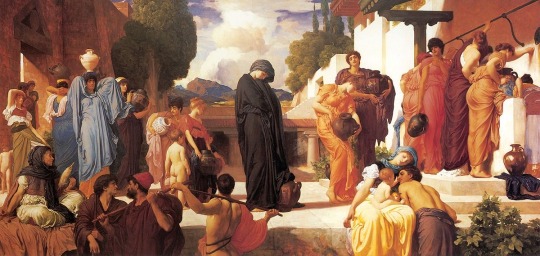
in the Iliad, Andromache begs her husband, Hector, to be careful on the battlefield, as he is the last family she has left, and if he dies there will be nobody to protect her and their baby son, Astyanax. Hector agrees, sharing his fears that if he dies and Troy falls, she will be enslaved and taken to Greece. they tactfully don't mention what would happen to Astyanax, and instead share a sweet moment where he doesn't recognise his father in his helmet, and they laugh through their tears.
this painting is set after that. Hector has died in battle, Troy has fallen, Astyanax was murdered. Andromache is a slave in a foreign land, dressed in mourning black, sent to collect water. around her, life goes on, people bustling about, some stopping to look at her and gossip about the sad fate of the princess of Troy. Andromache ignores them all, standing still at the centre... her gaze fixed on a happy young couple with a baby, lost in their own world.
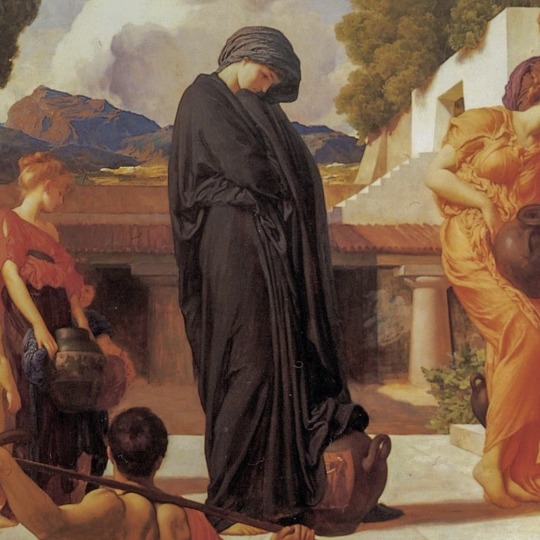

tags: @forabeatofadrum @cutestkilla @run-for-chamo-miles @roomwithanopenfire @prettygoododds @bookish-bogwitch @ic3-que3n @blackberrysummerblog @j-nipper-95 @youarenevertooold @larkral @orange-peony @aristocratic-otter @thewholelemon @alexalexinii @confused-bi-queer @shrekgogurt @comesitintheclover @raenestee @hushed-chorus @you-remind-me-of-the-babe @noblecorgi @shemakesmeforget @ileadacharmedlife @supercutedinosaurs @artsyunderstudy @otherpeoplesheartachept-2 and @ninemagicks
25 notes
·
View notes
Text

Mordechai Frizis (1893–1940), a Hellenic Army Colonel from the ancient Romaniote Jewish community of Chalkis, with his wife Victoria.
in the years that led up to World War II, the new government led by Ioannis Metaxas instilled into the Jews a sense of self-identification as Greeks. 13,000 Greek Jews served in the Greek army against the Italians in the Greco-Italian campaign. In fact, one battalion was called the “Cohen Brigade,” comprised of Jews from Salonica who fought in front line action. Many were killed or wounded alongside their Christian brethren. One such soldier was Colonel Mordecai Frizis, the first high-ranking Greek officer to die in World War II. While leading his troops on horseback in Epirus, he was mortally wounded, yet, he refused to dismount. With full knowledge that he would not survive, he gave orders to his loyal followers to press the attack, giving the Greeks and the Allies their first victory.
92 notes
·
View notes